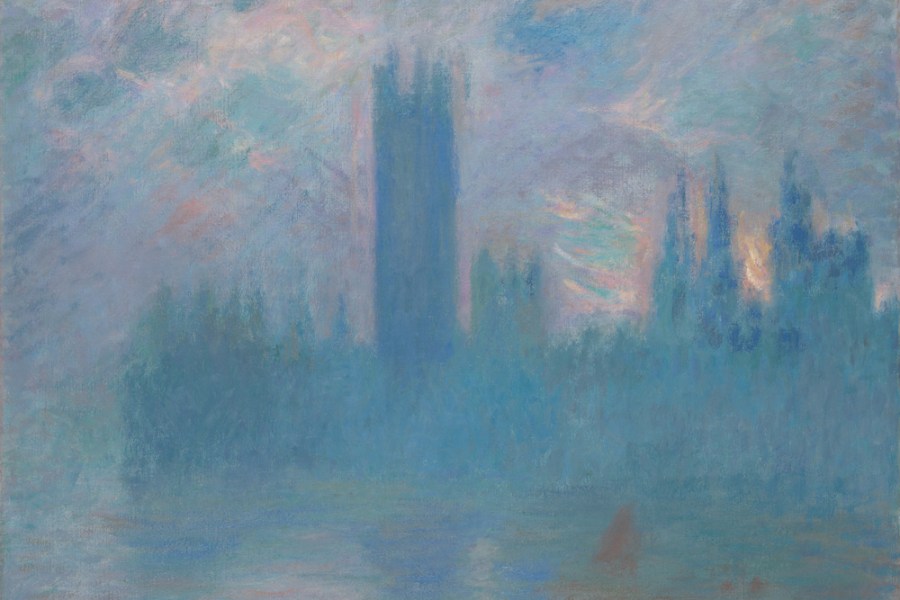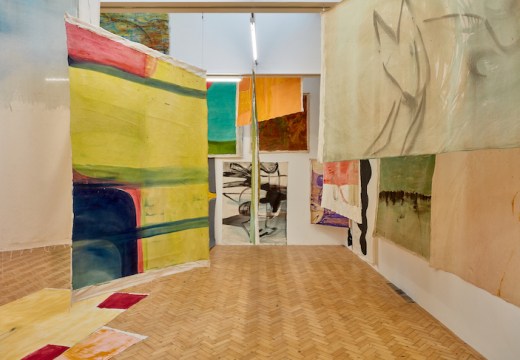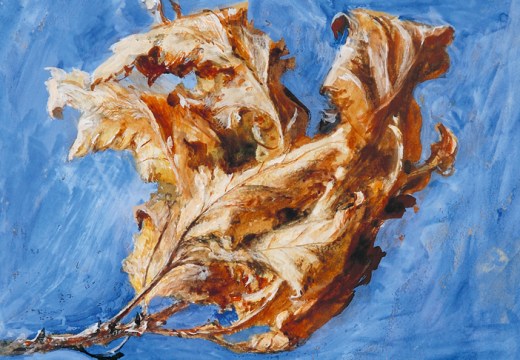From the July/August 2023 issue of Apollo. Preview and subscribe here.
In 1924, the critic Gustave Geffroy recalled watching Claude Monet at work in London in 1900. Positioned by the Thames in early morning darkness, Monet peered through the fog, waiting for the opportune moment: ‘The waves of the Thames swelled, almost invisible in the fog. A boat passed like a ghost. The bridges were barely discernible in space; on them an almost imperceptible movement animated the thick fog […] Suddenly Claude Monet seized his palette and brushes. “The sun has returned”, he said, but at that moment he was the only one who knew it.’ A catalogue of fogs makes the London that Monet and Geffroy saw painterly: ‘Lemon yellow, thick and green like a pea soup, strewn with the colours of nasturtiums and hyacinths.’ What begins as invisibility, concealment, transforms for Geffroy over the course of this passage into a source of lucidity – a paradoxically clearer form of vision than might be possible without the haze. Seeing London rightly involves seeing what is at first ‘imperceptible’.
 Evan Firestone aims to turn our attention to the mists that have hovered about British and European painting since Leonardo (though with a focus on painting from the 18th to the early 20th centuries) and which have hitherto received little critical notice. This is an ambitious project, given that Firestone might reasonably be said to take the whole history of European painting as his focus. Indeed, as he notes early on: ‘There is no telling how many museum-quality paintings of mist and fog exist.’ Early chapters move briskly through the Renaissance to 16th- and 17th-century Dutch painting, through the history of Gothicism and into the Romantic period, which is his main focus. Such rapid flipping between instances of what he neatly dubs ‘tangible atmospheres’, while dizzying at times, highlights how pervasive mists have been as a feature of European painting across styles and traditions. Indeed, it is primarily a ‘diversity of meanings, uses and methods’ of fog that Firestone seeks to bring to light. Thus, while the author does not find noteworthy scholarship within art history on the uses of obscurity, his ideas chime with those of scholars working in other disciplines such as Allon White, for instance, or Justine Pizzo, whose ‘solid air’ is a literary-critical counterpart to Firestone’s ‘tangible atmosphere’. The approach adopted by Firestone has the advantage of encouraging original comparisons, allowing for lines of stylistic and thematic resemblance to be traced across periods and between artists who might not usually be spoken of together. Henry Fuseli’s macabre atmospherics in The Serpent Tempting Eve (1802) are, for instance, placed in conversation with the muscular clarity of William Blake’s The Temptation and Fall of Eve (1807). J.M.W. Turner is positioned not just as an heir to Claude Lorrain’s contre-jour harbour scenes, but also to the colour-washed sublimity of Caspar David Friedrich. Continuities between, for example, Coast Scene with Europa and the Bull (1634) by Lorrain or Claude-Joseph Vernet’s Morning: A Port in the Mist – Fishermen Hauling in their Boat (1751) and Sun Rising through Vapour (1807) by Turner suggest not just shared themes, but a line of stylistic and technical resemblance with tendrils reaching through the whole history of painting after the Renaissance.
Evan Firestone aims to turn our attention to the mists that have hovered about British and European painting since Leonardo (though with a focus on painting from the 18th to the early 20th centuries) and which have hitherto received little critical notice. This is an ambitious project, given that Firestone might reasonably be said to take the whole history of European painting as his focus. Indeed, as he notes early on: ‘There is no telling how many museum-quality paintings of mist and fog exist.’ Early chapters move briskly through the Renaissance to 16th- and 17th-century Dutch painting, through the history of Gothicism and into the Romantic period, which is his main focus. Such rapid flipping between instances of what he neatly dubs ‘tangible atmospheres’, while dizzying at times, highlights how pervasive mists have been as a feature of European painting across styles and traditions. Indeed, it is primarily a ‘diversity of meanings, uses and methods’ of fog that Firestone seeks to bring to light. Thus, while the author does not find noteworthy scholarship within art history on the uses of obscurity, his ideas chime with those of scholars working in other disciplines such as Allon White, for instance, or Justine Pizzo, whose ‘solid air’ is a literary-critical counterpart to Firestone’s ‘tangible atmosphere’. The approach adopted by Firestone has the advantage of encouraging original comparisons, allowing for lines of stylistic and thematic resemblance to be traced across periods and between artists who might not usually be spoken of together. Henry Fuseli’s macabre atmospherics in The Serpent Tempting Eve (1802) are, for instance, placed in conversation with the muscular clarity of William Blake’s The Temptation and Fall of Eve (1807). J.M.W. Turner is positioned not just as an heir to Claude Lorrain’s contre-jour harbour scenes, but also to the colour-washed sublimity of Caspar David Friedrich. Continuities between, for example, Coast Scene with Europa and the Bull (1634) by Lorrain or Claude-Joseph Vernet’s Morning: A Port in the Mist – Fishermen Hauling in their Boat (1751) and Sun Rising through Vapour (1807) by Turner suggest not just shared themes, but a line of stylistic and technical resemblance with tendrils reaching through the whole history of painting after the Renaissance.
The fact that Firestone takes mists and fogs to be not just themes of the paintings with which he is fascinated, but also aspects of their technical achievement, allows for this flexible way of tracing similarity. This method is at times suggested by the artists he examines. Turner, for instance, once declared to John Ruskin that ‘atmosphere is my style’. For Firestone, such an intermingling of style and subject originates with Leonardo, who counselled that it was important to paint portraits ‘at twilight, or when there are clouds or mist’. But if there were no mists available, he advised that one might simply ‘pretend that there is some sort of mistiness or transparent cloud placed between the object and the sun’.
Firestone’s comfort with both literal and figurative fogs allows him to include works where there might seem, at first, to be none – Rocky Landscape (1830) by Carl Friedrich Lessing, for instance, or even Monet’s Water Lilies series – while finding thematic or aesthetic uses for obscurity. One of the attractions of mist lies in its capacity for connection, for rendering porous the usually hard outlines of things. Yet, working in this way also has its hazards, and Firestone occasionally risks abandoning scholarly precision in favour of suggestiveness and connection – all mists threaten to become one mist.
Shuttling between style and subject, however, can be Firestone’s most engaging critical tool, enabling him to hint at a relationship between Leonardo’s harmonising sfumato and Monet’s atmospheric enveloppe. If he stops short of settling what that relationship may be, this perhaps suits his theme.
Firestone can be at his most definitive about the meanings of mists when he turns to literature. At times, he resorts to variousness as an explanatory tactic: ‘The long association of vaporous atmosphere with the passage of time, the vagaries of memory and feelings of uncertainty, […] evil, presentiments of death, […] spiritual splendours and the terrors of the supernatural’, etc. At other points, he is a chronicler of more penetrating responses to haze, from William Wordsworth to Joseph Conrad to Oscar Wilde, who observed in ‘The Decay of Lying’ (1891) that ‘there may have been fogs for centuries in London. […] But no one saw them, and so we do not know anything about them. They did not exist till Art had invented them.’ For all his insouciance, Wilde sees that the mists that drift through the history of painting represent a crucial way in which artists have sought to shake landscape free of its inertness and make it meaningful. Firestone sees this too, and this book offers a valuable chronology of that attempt.
Mist and Fog in British and European Painting by Evan R. Firestone is published by Lund Humphries.
From the July/August 2023 issue of Apollo. Preview and subscribe here.
Unlimited access from just $16 every 3 months
Subscribe to get unlimited and exclusive access to the top art stories, interviews and exhibition reviews.














![Masterpiece [Re]discovery 2022. Photo: Ben Fisher Photography, courtesy of Masterpiece London](http://www.apollo-magazine.com/wp-content/uploads/2022/07/MPL2022_4263.jpg)
It’s time for the government of London to return to its rightful home